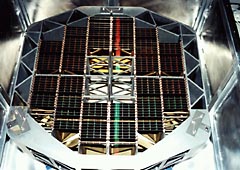
A view of an XMM-Newton Reflection Grating Array, illuminated by optical light in the same way as X-ray light would enter in flight.
XMM-Newton is the first X-ray mission to fly a reflection grating. It can identify lines of elements like iron, oxygen, silicon, and magnesium, which are common in astrophysical plasmas. Many institutions participated in the construction of the RGSs: Mullard Space Science Laboratory (MSSL), the Paul Scherrer Institute (PSI) in Villigen (Switzerland), Space Research Organisation Netherlands (SRON), and Columbia University (New York USA).